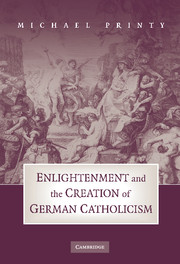Book contents
- Frontmatter
- Contents
- Acknowledgments
- 1 Introduction
- Part One PERFECT SOCIETIES: RETHINKING THE CHURCH AND THE STATE
- 2 The Liberty of the German Church: Febronianism and the German Gallicans
- 3 The German Church and the Absolute State
- 4 Church and Empire in the Eighteenth Century
- 5 Collegialism: The Rise of the State and the Redefinition of the Church
- Part Two THE UNIVERSAL CHURCH AND THE UNIVERSAL CLASS
- Bibliography
- Index
4 - Church and Empire in the Eighteenth Century
Published online by Cambridge University Press: 02 July 2009
- Frontmatter
- Contents
- Acknowledgments
- 1 Introduction
- Part One PERFECT SOCIETIES: RETHINKING THE CHURCH AND THE STATE
- 2 The Liberty of the German Church: Febronianism and the German Gallicans
- 3 The German Church and the Absolute State
- 4 Church and Empire in the Eighteenth Century
- 5 Collegialism: The Rise of the State and the Redefinition of the Church
- Part Two THE UNIVERSAL CHURCH AND THE UNIVERSAL CLASS
- Bibliography
- Index
Summary
“GERMANIAE EPISCOPI PRINCIPES SUNT”
“The bishops of Germany are princes,” the Jesuit Adam Contzen laconically declared in 1621. “Italian bishops,” he continued, “are not.” With the exception of the papal states, in which even Hobbes recognized the pope as sovereign, that temporal power was invested in the bishop was indeed the distinguishing characteristic of the German episcopate. This peculiarity meant as well that any realignment of the church in Germany would also touch the fundamental structure of the Empire. Issues of Catholic reform were of general interest because the fate of the Reichskirche was inseparable from the fate of the Empire itself.
The bishops were endowed with ecclesiastical foundations (Stifte) over which they ruled – in conjunction with the cathedral chapter – as lay lords. Ideally, territorial independence assured that a bishop would not be hindered in the exercise of his sacred office. In reality, wealth and power in the hands of these bishops was often a source of criticism and rebuke ever since the later Middle Ages, and complaints had sharpened considerably at the time of the Reformation. Moreover, a bishop's spiritual and secular jurisdictions did not necessarily coincide. This meant, for example, that a bishop would at times have to rely on the goodwill of a neighboring lay prince – or possibly even another bishop – to enforce his religious authority, whereas he may have subjects under his territorial jurisdiction who belonged to a different diocese.
The ecclesiastical principalities were the Empire's oldest institutions.
- Type
- Chapter
- Information
- Enlightenment and the Creation of German Catholicism , pp. 82 - 100Publisher: Cambridge University PressPrint publication year: 2009

